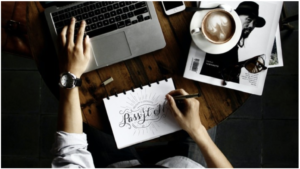for Getting Started With Fonts in Graphic Designing

In graphics design services, typography is the technique and art of designing and arranging typefaces to make written language readable and visually appealing. Additionally, in typography, readability determines the success or failure of a design. Readability, on the other hand, refers to how easily viewers can read the text. If the text is difficult to read, there may be issues with placement, alignment, colour, and font choice. By following the rules of typography, you can ensure that your design is easy to read. In this guide, we’ll explore the basics of typography, focusing on fonts, their classifications, and how to use them in graphic design effectively.
Understanding Fonts and Typeface
A typeface in graphic design is like a family of fonts that have a similar style. It’s like a group of fonts that go together and have the same overall look and feel. Each typeface can have different variations, like bold or italic. Choosing the right typeface is important because it helps set the mood and one of your designs. It’s kind of like picking the right outfit for your text to make it look good and easy to read. In graphics design services, the font is like the letter’s style and character you use; it’s like a specific look and design of text. Fonts have different sizes, styles, and shapes, like simple or fancy.
Font Classifications
Understanding these classifications can help you choose the best font for your design. Fonts can be classified based on their visual attributes.
1. Serif Fonts:
In graphic design, serif font is a type of font that has small lines or strokes at the ends of the letter. These lines are called serifs.
2. Sans-Serif Fonts:
In graphic design, sans-serif fonts are a type of font that does not have small lines or strokes at the end of the letters. These lines are called sans-serif font.
3. Script Fonts:
Script typefaces give a touch of class and personality by simulating handwritten or calligraphic styles. They are frequently employed in logos, invitations, and imaginative designs.
4. Display Fonts:
Display fonts are strong and recognisable, made to draw attention. They are perfect for projects involving creative typography, posters, and headlines.
5. Monospaced Fonts:
Characters in monospaced fonts have an equal amount of space between them. They are frequently employed in coding, where alignment is important.
6. Decorative Fonts:
Decorative fonts are highly styled and distinctive. As they might be difficult to read in lengthy stretches, they should only be utilised on rare occasions.
Graphics Design Services: Tips for Effective Font Usage:
1. Contrast:
Pairing fonts from various categories will create contrast. As an illustration, use a bold sans-serif headline and legible serif body text. This contrast heightens the appeal of the image.
2. Hierarchy:
Use distinct fonts for headlines, subheadings, and body text to create a clear hierarchy. This directs the reader’s attention and aids in the efficient delivery of information.
3. Consistency:
To preserve a unified and polished image, choose just a few fonts. Visual clutter can result from using too many fonts.
4. Legibility:
Place legibility above novelty. Although fancy or overly ornamental typefaces may appear engaging, if they are difficult to read, your message will be missed.
5. Spacing and Alignment:
Pay close attention to the alignment, leading, and kerning of the letters. Approved spacing improves aesthetics and readability.
6. Context and Branding:
Choose fonts that align with the message and the brand you’re representing. A playful font might not suit a serious financial report, for instance.
7. Responsive Design:
Think about how typefaces will appear on different devices and screen sizes while designing for digital platforms. Consider utilising web-safe fonts or adding fonts via web technologies.
8. Testing and Proofreading:
To ensure readability, always test your design with several fonts and sizes. Also, proofread your writing as well to find any errors or contradictions.
Typography is a powerful graphic design tool. In addition, it may engage an audience, improve message delivery, and convey emotions. You can build aesthetically beautiful and powerful designs that effectively convey your message by comprehending font classifications, using contrast and hierarchy, and putting readability first.
But, remember that using the appropriate font can make your material more readable and interesting. Also, graphic design plays an important role in the success of every brand. Graphics design services in typography involve creating visually appealing and readable designs using different font styles, sizes, and arrangements. There are thousands and millions of graphics design services providers who are providing the services one of them is E1W Media.

